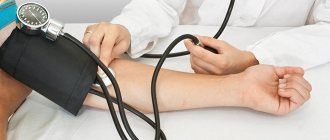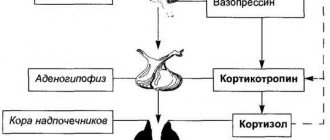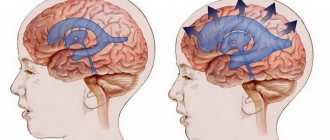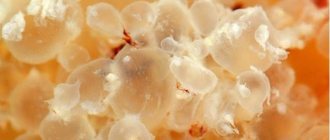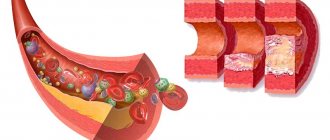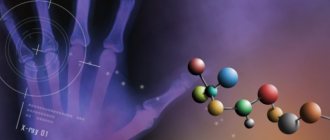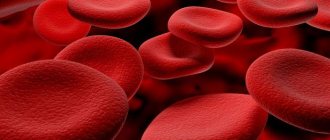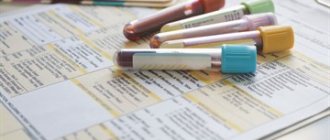Hormones
08/22/201801/25/2019 Yulia Martynovich (Peshkova) 1657 Views AMH, anti-Mullerian hormone, hormonal studies
We talk about anti-Mullerian hormone, what it shows and what it is needed for, what is the norm for women by age. According to socio-statistical studies in 2020, the average age for the birth of the first child among Russian women was 27.5 years. The trend of giving birth at a later age is due to financial and psychological aspects. Couples begin to plan for children long in advance and try to gain financial independence and independence.
It should be borne in mind that after 31 years of age, a woman’s likelihood of becoming pregnant begins to gradually decrease.
In order to assess the supply of remaining resting follicles that are still capable of fertilization, a test for anti-Mullerian hormone is carried out. The advantage of the analysis is the constant value of the hormone, which does not depend on the phase of the menstrual cycle.
The cost of research for private laboratories starts from 850 to 1200 rubles. An immunological method is used followed by detection in ultraviolet light. The waiting time for results can be up to 7 days.
- 1 What does anti-Mullerian hormone affect in women?
- 2 What does anti-Mullerian hormone show? 2.1 Anti-Mullerian hormone - when is it analyzed and how to take it?
- 5.1 How to bring the indicators back to normal?
Anti-Mullerian hormone: what is it and what is it responsible for?
Anti-Mullerian hormone or AMH is an organic substance whose production is affected only by the functional reserve of the ovaries. The brain does not take any part in this process.
Anti-Müllerian hormone got its name from the scientist who first described the existence of a specific tubular formation in the embryo, called the Müllerian duct. Common to both sexes initially, it subsequently develops into female or male genital organs. In this case, development according to the female type occurs by default. Only the production of anti-Müllerian secretion prevents the development of female reproductive structures and stimulates the formation of male ones. This division occurs around the sixth week of intrauterine development, when AMH is produced by the Sertoli cells of the testicle.
It is secreted in both sexes: in women in the ovaries, in men - in the seminiferous tubules. Its formation begins in utero, affecting the normal formation of the genital organs and the formation of follicles. It is interesting that during puberty, the production of the substance is more active in boys than in girls, and after puberty it gradually decreases, remaining consistently low throughout a man’s life.
A constant volume of this compound in the blood of women is maintained only until puberty begins. After passing this stage, its quantity changes under the influence of various factors. Anti-Mullerian hormone reaches its maximum level by the age of 20-30, and as menopause approaches, its amount gradually decreases to a minimum. Müllerian substance is an inhibitor that is responsible for stimulating follicular production. Subsequently, they must mature and be able to perform their tasks of fertilizing the egg. When a woman does not produce viable follicles, we can talk about problems with reproductive function. To detect disturbances in the concentration of this substance in the blood, it is necessary to do an AMH (amg) test. The functional reserve of the ovaries is assessed on the basis of different data, but according to experts, the AMH level in this case is the most important indicator of the condition.
Anti-Mullerian hormone is elevated: what does this mean, what is the role of the substance
Anti-Mullerian hormone (the norm is calculated based on age and health) is a substance produced by ovarian cells that affects the appearance of eggs in women.
Anti-Mullerian hormone is produced by the body already at the 32nd week of the embryonic state; it is present in both the male and female body, but in men its concentration is much lower. In the embryonic state, a ductal tube (müller) begins to form. In males, it disappears at the 10th week, and in females, the uterine space is formed from it. The hormone begins to play an important role in a girl’s body during puberty.
After menopause, the hormone ceases to exist, this is due to the cancellation of the process of egg formation.
Starting from the age of 12, the concentration of the hormone gradually increases. From the age of 20-30, hormonal levels are at their peak, and after 30 years, the concentration declines, and the body gradually prepares for the onset of menopause. During menopause, hormone production stops.
Anti-Mullerian hormone, the norm in women, has a wide range and is not influenced by the menstrual cycle. For each woman, the meaning is different, since the supply of fertile eggs is individual for everyone. Normal hormone values in girls under 8–9 years of age range from 1.7–5.3 ng/ml.
| Name | Normal (ng/ml) | Increased (ng/ml) | Decreased (ng/ml) |
| 1. By age (years) | |||
| 1.1. 20-24 | 1,88-7,29 | ≥7,30 | ≤1,87 |
| 1.2. 25-29 | 1,83-7,53 | ≥7,55 | ≤1,82 |
| 1.3. 30-34 | 0,95-6,70 | ≥6,71 | ≤0,94 |
| 1.4. 35-39 | 0,777-5,24 | ≥5,25 | ≤0,78 |
| 1.5. 40-44 | 0,097-2,96 | ≥3,00 | ≤0,095 |
| 1.6. 45-50 | 0,046-2,06 | ≥2,1 | ≤0,045 |
Only a medical specialist should decipher the analysis data. If the test was taken on the woman’s personal initiative, then it is necessary to visit a doctor to get a reliable answer. Only, but it can explain the changes taking place in the female body.
An abnormal state of AMH concentration in a woman’s body indicates its abnormal development or a pathological process occurring in the ovarian cavity. What exactly happens with the production of the hormone can be understood after taking blood for analysis.
The consequences of deviations from normal hormone concentrations are directly proportional to the reasons that caused the imbalance. If maintenance therapy is not taken in time for elevated AMH concentrations, then most likely the woman will not be able to get pregnant on her own.
Normally, AMH begins to be produced before birth, during 32–36 weeks of pregnancy. However, up to puberty, its amount is insignificant. The concentration of AMH increases sharply during puberty, and reaches a maximum between 20 and 30 years of age in women. Further, the secretion of the hormone decreases, but remains stable until the onset of menopause. Why does its content change so much?
In general, the number of eggs in a woman’s body is determined at the time of their laying, at 11-12 weeks of intrauterine development. However, the reverse process of death of the primary follicles, which is called atresia, immediately begins. So by the time of birth, the number of eggs in the body of a newborn girl decreases several times, to 1.5 million, and at the time of the first menstruation there are no more than 300 thousand left.
All this huge number of follicles are in a “dormant” state and will never be used - these are the so-called primordial follicles, about 50 microns in size (they can only be detected during microscopic examination of tissues). During a woman's lifetime, no more than 500 of them can mature.
This process is “triggered” by the action of follicle-stimulating hormone (FLH), which begins to be produced in the brain (pituitary gland) during puberty. Of course, not all follicles mature at once - about 25 follicles are simultaneously in the preantral and antral phases of development. Their size is already from 150 to 500 microns, and they can be easily detected (and counted) during ultrasound examination.
When the size of the follicle reaches approximately 8 mm (the stage of a large antral follicle), instead of it, another anti-Mullerian hormone begins to be produced, called inhibin B. It gives the pituitary gland feedback - “that’s it, FSH should no longer be produced, the required number of follicles ready for ovulation has already been achieved.”
As you probably understand, anti-Mullerian hormone is produced directly by maturing follicles. Its amount does not depend on the phase of the menstrual cycle. Its concentration does not directly affect the processes of conception and pregnancy (since it ceases to be produced in a mature egg).
Of course, the number of antral follicles can be assessed using ultrasound, but such a study is subjective, and its results inevitably depend on both the quality of the equipment used and the skill of the specialist. AMH analysis is impartial and completely accurate, which is why it is used in preparation for the IVF procedure.
As you will notice, the concentration of AMH in a woman's body increases at the time of puberty, reaches a maximum at the peak of fertility from 20 to 30 years, and gradually decreases to zero at menopause.
| Age | AMH content, ng/ml blood |
| Before the onset of puberty | 1.8-3.4 |
| Beginning of the reproductive period (up to 20 years) | 2.1-6.8 |
| 20-30 years | 3.2-7.3 |
| From 30 | 2.6-6.8 |
| Premenopause | 1.1-2.6 |
| Climax | 1.1-0 |
The reasons that cause a decrease in AMH levels do not necessarily indicate potential infertility. For example, if a woman has one ovary or part of it surgically removed, then the AMH level may be reduced, but this does not prevent the natural occurrence of pregnancy.
In general, we can say with regret that the reasons causing a decrease in the production of anti-Mullerian hormone are not completely clear. In addition to the obvious ones (menopause, ovarian surgery, use of hormonal medications), there are also non-obvious cases of decreased AMH. One of the reasons may be obesity.
The AMH level may be higher than normal, and this also does not indicate reproductive health and high fertility. Thus, the concentration of anti-Mullerian hormone is often higher in women with polycystic ovary syndrome, and an ultra-high level indicates the presence of granulosa cell tumors of the ovaries.
An increase in AMH in the blood can be caused by a number of factors. All causes of increased anti-Mullerian hormone can be divided into two large groups.
The first would include situations where normal, healthy antral follicles work well, but do not reach beyond the ovaries. This is exactly the situation that occurs with polycystic ovary syndrome (PCOS). The follicle grows and develops, but cannot penetrate the cystic surface.
In the second option, the rise in AMH levels occurs due to an increase in the mass of granulosa tissue. The most likely cause of this growth is tumor transformation of the ovaries. Due to the fact that the approach to managing such women differs radically, it is necessary not to solve the question of what to do if anti-Mullerian hormone is elevated, but to identify the reason that led to such a change.
It is the treatment of the underlying disease that led to an increase in the concentration of the hormone, and not the solution to the question of how to lower anti-Mullerian hormone in women, that will lead to a positive result. This is especially true due to the fact that AMH levels are not affected by other hormones. In a condition where anti-Mullerian hormone is elevated, the causes, consequences and treatment of this condition will be identified by the attending physician.
An isolated decrease in AMH will not lead to the desired result, as it reflects the activity of primary follicles in the granulosa layer. To normalize its functioning, it is necessary to treat the underlying disease that led to an increase in the concentration of the hormone (PCOS or hyperplastic processes). They lead to an increase in anti-Mullerian hormone. Treatment will depend on the diagnosis.
AMH is one of the key hormones that affects conception. Its deficiency and excess can lead to infertility.
For a woman, the implementation of childbearing function is the main purpose. When, despite normal levels of essential hormones, she cannot become pregnant, the endocrinologist prescribes appropriate tests. High anti-Mullerian hormone in women signals problems and pathologies that require immediate treatment.
Anti-Mullerian hormone analysis: indications for performance
If many attempts have been made to conceive a child, but there is no result - pregnancy does not occur, then in this case an AMH analysis is mandatory.
In addition, the reason why they may be referred for laboratory testing of anti-Mullerian substances is:
- disorders of sexual development, congenital anomalies;
- several unsuccessful attempts at in vitro fertilization;
- granulosa cell tumor of the ovaries;
- suspicion of polycystic ovary syndrome;
- abnormal levels of follicle-stimulating hormone;
- infertility in men and women;
- control over the effect of antiandrogen therapy
- diagnosis of the causes of cryptorchidism in boys
- the need to assess the functional reserve of the ovaries in order to determine the timing of menopause.
This test should be done in order to prematurely detect the early onset of menopause, which occurs against the background of menstrual irregularities.
In addition, this is a necessary analysis for IVF (in vitro fertilization). The concentration of AMH in the body will allow the doctor to determine whether IVF is possible.
What to do in case of promotion?
It all depends on the cause of the increase in AMH, as well as therapeutic goals. For example, if the cause of an increase in the level of anti-Mullerian hormone is a granulosa cell tumor of the ovary, surgical treatment is required. But, as we have already found out, in most cases, elevated AMH occurs with polycystic ovary syndrome - 10% of the female population suffers from this disease. In this case, the method of treatment depends primarily on what the woman wants to get as a result of therapy. The goals may be the following:
- the onset of pregnancy;
- elimination of symptoms (primarily associated with hyperandrogenism);
- prevention of negative consequences of hormonal disorders (prevention of endometrial hyperplasia, obesity, increased cardiovascular risks, normalization of menstrual function and carbohydrate metabolism).
Whatever the goal, doctors do not prescribe treatment that is aimed at reducing AMH levels. With age, the concentration of this hormone will decrease on its own as ovarian function declines - just as it happens in other women.
In patients of reproductive age, treatment of polycystic disease is most often aimed at solving the problem of infertility. Currently, there are no treatments that would restore natural fertility permanently. Polycystic ovary syndrome is an incurable disease. But against this background, you can get pregnant and give birth to a child. For this purpose, ovulation induction programs are used. Usually a woman is prescribed clomiphene. If it does not work, they move on to stimulation with gonadotropins.
AMH analysis: preparation for passing
Women often have one question when they are sent for laboratory testing of AMH - how to take it correctly? It is better to get an answer from your attending physician. The likelihood of obtaining a more accurate result is higher if you follow the recommendations of the doctor with whom you are being treated. Among the general requirements, we note the importance of a relaxed and calm state immediately before conducting laboratory tests.
Doctors agree that the ideal time to take this hormonal test is 3-5 days of menstruation. During this period, the connection is stable, which allows you to find out its real amount.
Before taking the test, it is important to follow the preparation rules. If the doctor did not draw attention to them, then it is better to ask him yourself. Doctors give the following recommendations:
- pay more attention to rest and relaxation;
- The analysis is carried out in the morning, on an empty stomach;
- eliminate alcohol consumption;
- three days before the test, you should not engage in physical activity;
- Some medications affect test results. For example, methyldopa helps reduce performance. This must be taken into account when preparing and deciphering the results.
If it happens that a woman has been diagnosed with any disease in anticipation of taking an AMH hormone test, then it is postponed until she is completely recovered.
How many days the analysis takes depends on the laboratory. On average, the waiting time for results does not exceed three days.
How to take the test correctly
The ovarian cavity is formed from follicles in which the egg, ready for fertilization, matures. Most of the follicles exist in a quiet state, with one egg maturing every month. Follicles that rest in the ovarian cavity secrete the hormone, and those that are already mature stop doing so.
A blood sample shows how many follicles are dormant and ready to enter the readiness stage. The ability to conceive and the rate of onset of menopause depend on the concentration of AMH.
There are several indications when it is worth analyzing the AMH concentration:
- establish the stage of puberty of the girl (earlier or later);
- find out the sex of the child if hermaphroditism is observed;
- assess female (male) fertility;
- find out what the reserve of eggs is in a woman’s ovaries;
- record the onset of early menopause;
- detect ovarian cancer and monitor its development;
- record the enlargement or reduction of the ovaries;
- unsuccessful IVF attempts;
- infertility.
Low levels of anti-Mullerian hormone lead to infertility
If a woman has an acute problem conceiving a child, medical experts recommend taking blood to study the concentration of anti-Mullerian hormone in the next 30 days after the start of the menstrual cycle.
The study should be carried out several times, and if there is a risk of infertility, it is necessary to extract fertile eggs in order to freeze them for subsequent artificial insemination.
Anti-Mullerian hormone, the norm of which in women depends on age, may indicate the development of pathology in the reproductive system. Usually, women with a normal cycle are prescribed a test on the 3rd cyclic day, since blood is taken together for other hormones.
On the 3rd day of the cycle, an analysis is also taken for the concentration of AMH for artificial insemination and in case of a broken cycle. In other cases, blood sampling is required on the fifth or fourth day of the cycle.
To get reliable results, you need to follow a number of rules:
- in the morning before blood sampling, do not eat or drink anything;
- Eliminate physical exercise and don’t be nervous for four days;
- do not donate blood for AMH if you have recently had an acute illness;
- before the test (one hour) you need to avoid smoking;
- Do not eat fried or fatty foods during the day, and do not drink alcohol.
If there are any other rules that must be followed before taking the test, the medical specialist will warn you and give recommendations. The results will be ready after 2-3 days; in some situations, laboratory tests may take up to a week. Only the attending physician makes a diagnosis and deciphers the indicators.
To detect elevated AMH hormone, doctors recommend getting tested. The procedure is performed on the 3-5th day of the menstrual cycle. Before this, you need to lead a quiet life for three days, without stress bursts or physical activity. At least 8 hours must pass between food intake and blood sampling.
Although the AMH level generally does not depend on the phase of the menstrual cycle, for convenience it is usually taken along with other hormonal tests on days 3-5 of the cycle. Before analysis it is not recommended:
- eat food within 2-3 hours (you can drink clean water without restrictions);
- stop taking hormonal medications two days before the test (only by agreement with your doctor!);
- exclude physical and emotional stress for at least a day before taking the test;
- do not smoke for 3 hours before the test.
Although the concentration of AMH is almost independent of the phase of the menstrual cycle, its fluctuations are possible over a short period of time (the reasons for this have not been fully investigated).
So if the test results are unsatisfactory, don’t panic, the doctor will definitely advise you to retake it and, perhaps, next time the results will be more optimistic.
24.06.2018
Prepared by Anna Pervushina
tests
,
medical examinations
,
physiology
Evaluation of normal test results
The norm for women of reproductive age is represented by the range – 2.2 – 8 ng/ml. When observing any deviations from these limits, one can assert the presence of a pathological process. Considering the dependence of the indicator on gender, age, and various negatively influencing factors, independent interpretation of the results is extremely undesirable. It is better to follow the advice and recommendations of specialists. You should never rule out false indicators. As a rule, this is due to the fact that the woman is not properly preparing for the examination or the wrong day was chosen for the test. If you have any doubts about the result obtained, it is advisable to have your blood tested again, but in a different laboratory.
The following table shows the AMH norm in women depending on age: age norm is less than 14 years 0 – 8.9 14-40 years 1.0 – 12.6 over 40 years 0 – 1.0
| age | norm |
| less than 14 years old | 0 – 8,9 |
| 14-40 years | 1,0 – 12,6 |
| more than 40 years | 0 – 1,0 |
The norm for women of reproductive age is represented by the range – 2.2 – 8 ng/ml. When observing any deviations from these limits, one can assert the presence of a pathological process. Considering the dependence of the indicator on gender, age, and various negatively influencing factors, independent interpretation of the results is extremely undesirable. It is better to follow the advice and recommendations of specialists. You should never rule out false indicators. As a rule, this is due to the fact that the woman is not properly preparing for the examination or the wrong day was chosen for the test. If you have any doubts about the result obtained, it is advisable to have your blood tested again, but in a different laboratory.
The following table shows the AMH norm in women depending on age: age norm is less than 14 years 0 – 8.9 14-40 years 1.0 – 12.6 over 40 years 0 – 1.0
Reasons for demotion or promotion
The following factors can provoke an increase in AMH:
- bad heredity;
- pathologies in the ovaries;
- undergoing radiation or chemotherapy;
- long-term use of certain types of medications;
- infectious diseases;
- tumor processes;
- venereal diseases, etc.
A decrease in hormones can be caused by the following components:
- approaching menopause;
- depleted supply of eggs;
- ovarian dysfunction;
- early puberty;
- bad heredity, etc.
Conditions that affect the level of anti-Mullerian hormone in the blood
In medical practice, there are often cases when abnormally high levels of AMH are observed in the blood of women. A logical question arises: what does this mean and why does this happen? Anti-Mullerian hormone in women is elevated with the following problems:
- Stein-Leventhal syndrome, in which ovarian dysfunction occurs;
- anovulatory infertility;
- problems with the functioning of the receptors responsible for the generation of luteinizing hormone;
- ovarian tumor or granulomatous process.
Sometimes we ourselves contribute to the fact that we have elevated anti-Mullerian hormone. Abuse of bad habits such as smoking and excessive consumption of alcoholic beverages often lead to elevated AMH.
If the doctor discovers that anti-Mullerian hormone is elevated, then additional tests are prescribed. After they have passed, treatment will be prescribed, the purpose of which will be to normalize the amount of hormones. In most cases, if a woman follows all the instructions, the treatment gives a positive result.
Polycystic ovary syndrome is the most common pathology, which leads to an increased level of anti-Mullerian substance. In this case, physical activity and diet are prescribed as treatment. Therapy is also carried out to help normalize metabolism. If the treatment does not give the desired results, and the value of the indicator is as high as it was, and the patient did not manage to wait for the long-awaited pregnancy, then you may have to think about surgical intervention. For cases in which the level of this compound in the body is high, scientists have not yet been able to develop drugs that can reduce the concentration of the substance in the blood to normal.
If the indicator is elevated, this is not a reason for frustration. You should seek help from specialists as quickly as possible: a reproductologist and an endocrinologist. Additional studies will help determine the reason why anti-Mullerian hormone is elevated and, based on their results, treatment will be prescribed.
The effect of AMH on fertility
Anti-Mullerian hormone is produced by the gonads . In the female body, it is responsible for the production of follicles, and, consequently, the ability to mature eggs.
If the chain is broken at the very beginning and follicles are not produced, then fertilization is impossible and the woman is not able to conceive naturally, as well as through IVF and using her own eggs.
We invite you to watch a video about the importance of AMH for conception:
Causes of low AMH
It happens that low AMH is observed in women . This happens in the following cases:
- sudden weight gain;
- when ovarian reserve decreases;
- ovarian failure; infertility;
- unnaturally rapid sexual development;
- mechanical damage to the ovaries;
- cycle disorders;
- genetic abnormalities.
Women after 40 years old experience premenopausal changes. This is the most common reason for low AMH. During this period, the first disruptions in the menstrual cycle begin to occur. Low values predominate in cases associated with premenopausal changes, which begin to appear in women after 40 years of age. This period is also characterized by the first irregularities in the menstrual cycle. AMG analysis allows, taking this knowledge into account, to predict the time of menopause with reasonable accuracy. Thus, a woman can be ready for this 4 years before it begins. This is important for women with premature menopause because they have a better chance of having children.
In addition to assessing the functional reserve and the risk of menopause, using an AMH test you can understand how great the risk of excessive ovarian stimulation is. This is important for the correct implementation of the IVF protocol, since hyperstimulation of ovulation is a dangerous syndrome. It is expressed by the production of many defective female reproductive cells, abdominal pain, bleeding due to mass ovulation. For women at high risk of this condition, gentle in vitro fertilization protocols are indicated.
For young people, low AMG is a consequence of excess weight and too rapid puberty. The use of drugs that affect hormonal levels during chemotherapy causes the ovaries to work at an unnaturally active pace. This overstrain significantly affects hormonal levels.
Pregnancy with low AMH concentration: is it possible?
If we take into account the fact that anti-Mullerian hormone is an indicator that allows us to assess the state of the ovaries and follicular reserve, then when dealing with its low concentration, there is an absence of a dominant follicle with an egg.
The consequence of this is the absence of ovulation. The presence of ovulation and the number of follicles are determined by ultrasound. This procedure will allow you to find out whether ovulation occurred or not. Also, the data obtained will help to find out how serious the situation is with a low level of the follicular apparatus.
If, during an ultrasound, the doctor detects the presence of ovulation and the level of hormones that are responsible for ovulation and the formation of follicles is within normal limits, then the woman will have a good chance of conceiving a child on her own or with the help of IVF, even with low laboratory values
Why does the hormone decrease?
In cases where anti-Mullerian hormone is low, suspicions arise about the presence of the following pathologies:
- ovarian failure;
- decreased ovarian reserve;
- onset of early menopause;
- obesity;
- premature puberty.
Accordingly, with a low level of this hormone, spontaneous pregnancy occurs very rarely. It is necessary to understand that AMH is just an indicator that shows the number of viable eggs.
Artificial stimulation of this indicator with medications, including hormonal ones, is possible. But in this case, the number of eggs, unfortunately, will not increase. In fact, the ovarian reserve will remain the same. The AMH level can only be increased if the reasons that initially lead to the absence of healthy eggs in the body are eliminated.
Is it possible to increase the concentration of AMH?
How to increase AMH in women is a common question that arises acutely for every expectant mother when she learns about poor results after taking the test. If laboratory tests show low AMH, then it is urgent to begin to deal with the source of the abnormality, which negatively affects the level of the hormone. Therapy can help ensure the desired pregnancy. This can be achieved by increasing the number of viable eggs. Doctors in some cases recommend artificial ovarian stimulation to women to increase the production of active eggs. Also, this procedure is done for IVF.
When thinking about the problem: how to increase anti-Mullerian hormone in women, you need to realize that this is not a source of pathology, but only a symptom. In order to bring the AMH hormone within normal limits in its volume, you need to start with treating the underlying disease. The level of development of pharmacology has made it possible to create hormonal medications capable of increasing the volume of AMH in the blood for a limited period. But this will not contribute in any way to increasing the number of fully functioning eggs. Therefore, this method will not cure infertility.
Recent research in pharmacology has become a solution to the problem. The DHEA drug has a positive effect on the volume of follicles and returns the AMH hormone to acceptable limits. It is a steroid hormone that stimulates androgen receptors. The drug allows you to increase the number of antral follicles. Only a doctor can prescribe these medications. Self-medication with hormonal medications can significantly harm your health.
Preparations with vitamin D3 to increase AMH
- Minisan. The drug is available in tablets (1 tablet contains 10 mcg of the substance), as well as in drops (5 drops = 12.5 mcg of vitamin).
- Aquadetrim (1 drop of the drug contains 12.5 mcg of vitamin).
- Vigantol (1 drop = 16.5 mcg of vitamin).
- Natekal D3. Chewable and lozenge tablets (1 tablet contains 10 mcg of vitamin D3).
How to increase AMH in women without using drugs?
There are harmless methods, following which will increase the amount of AMH in the blood, without the threat of hormonal imbalance. You can increase AMH in women using folk remedies, for example, getting vitamin D3 into the body naturally, taking sunbathing. In addition, you can safely take it in tablets; these vitamins are freely available in any pharmacy. If we compare AMH analyzes in summer and winter, then for the first case the concentration will be 15-18% higher.
How to increase anti-Mullerian hormone in women if its level deviates downward due to obesity or early menopause?
The most important thing in this matter is the elimination of the initial causes that lead to disturbances in the generation of the hormone by the eggs. To delay the onset of menopause, modern methods of hormonal therapy are used. The problem of excess weight can be solved by a nutritionist and competent correction of nutrition and lifestyle. In extremely rare cases, the level of the hormone decreases under the influence of stress, but after overcoming a difficult life situation, its level returns to normal.
Normalization methods
It is possible to normalize the amount of anti-Mullerian hormone provided that menopause has not yet occurred. When choosing a technique, doctors take into account the following factors:
- age group;
- the presence of concomitant pathologies;
- causes of hormonal fluctuations, etc.
To increase AMH, patients need to act as follows:
- take hormone-containing medications prescribed by your gynecologist/reproductologist;
- put your weight in order;
- switch to a balanced diet;
- normalize sleep;
- ensure proper rest;
- Give the body moderate physical activity.
| Age category of women | The level of hormone content in women for conception, which is taken as the norm (ng/ml) |
| 20-24 years | From 1.88 to 7.29 |
| 25-29 years old | Minimum - 1.83, maximum - 7.53 |
| From 30 years to 34 years | From 0.95 to 6.7 |
| 35-39 years old | Lower threshold - 0.777, upper - 5.24 |
| 40 years - 44 years | The minimum normal value is 0.097, the maximum reaches 2.96 |
| 45-50 years | From 0.046 to 2.06 |
| Age category | AMG content level (ng/ml) |
| Children's age up to 8-9 years | Lower threshold - 46.4, upper -78.1 |
| Puberty (from 9 to 15-16 years) | From 31.2 to 38.6 |
| End of puberty (sharp decline) | The minimum indicator is 48, the maximum is 9.6 |
| Reproductive age | From 4.8 to 5.6 |
If the level of biologically active substances shifts in one direction or another from the norm, this may mean the appearance of pathological processes in the ovaries. For a more detailed study of the disease and diagnosis, additional examination is required.
As for the consequences, they depend on how much the tests differ from the norm. A small difference may not be critical, but if the level is much higher or lower than the normal level of anti-Mullerian hormone in women, then problems with fertilization arise.
Low AMG reduces the chance of pregnancy, but there are a few other factors to consider to get a clearer picture. A lack of hormones is most often accompanied by the absence of follicles in the ovary. As a result of this pathology, the woman does not ovulate.
Ultrasound helps detect the presence of ovulation. If the test shows that ovulation occurred properly and the hormone levels were close to normal, then in some cases the woman can become pregnant on her own. Conception is also possible with the help of IVF.
AMG hormone and IVF
If blood tests show that anti-Mullerian hormone is elevated, then there is a possibility of developing ovarian hyperstimulation. This complication contributes to a decrease in blood circulation in the pelvis. In addition to the problems already mentioned, this syndrome provokes the appearance of edema, which poses a serious danger to life.
In vitro fertilization is allowed if the level of AMH in the body fluctuates between 0.6-2.4 ng/ml. A critical level of 1.1 ng/ml and below may indicate that the number of mature eggs that are ready for fertilization is not enough to guarantee a positive result.
It is important to remember that the level of this hormone acts only as an indicator. To prescribe treatment, you need to determine the source of the low level of the AMH hormone.
If the low level of AMH in the blood is not the result of age-related changes, but this pathology is caused by dysfunctions of the reproductive organs, then before IVF is performed, the diagnosed disease is first treated.
Whether IVF will bring the desired result largely depends on the level of anti-Mullerian hormone. Low indicators indicate that you cannot put off conceiving a child for a long time and if you want to become a mother, you need to act now. With low AMH, IVF is performed if the following 2 conditions are met:
- The level of anti-Mullerian hormone in the blood should not be less than 0.6 ng/ml. This is a limiting indicator that still allows you to find the required amount of genetic material to carry out successful fertilization)
- The level of follicle-stimulating hormone in the body should be within normal limits. If the concentration of FSH is exceeded in combination with reduced AMH, then the probability of a successful pregnancy tends to almost zero. With this combination of factors, a woman is recommended to use donor eggs.
Reproductive function can be impaired for many reasons. Therefore, a low AMH level does not mean that you can put an end to the possibility of conceiving a child. The main thing is to establish the cause of the anomaly, causing a failure in reproductive function. To do this, you will have to undergo the necessary tests and, based on their results, begin treatment. Modern medicine has many tools in its arsenal that allow women to feel the joy of motherhood.
